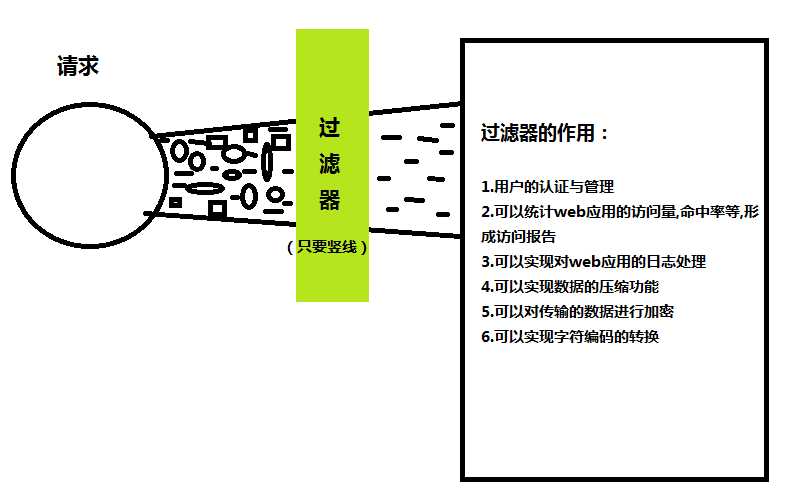标签:creat 会话 范围 服务 body 变化 web应用 span lan
一、过滤器简介
Filter 位于客户端和请求资源之间,请求的资源可以是 Servlet Jsp html (img,javascript,css)等。用于拦截浏览器发给服务器的请求(Request)和服务器返回给浏览器的内容(Response)。一言以蔽之:过滤器是用来筛选请求的。

* 怎么实现一个过滤器? 思路如下:
1) 编写一个类, 实现javax.servlet.Filter 接口
-- destory();
-- init(FilterConfig config);
-- doFilter(ServletRequest req,ServletResponse resp, FilterChain chain);
2) 在 web.xml 中进行配置
二、处理乱码的过滤器
public class CharaFilter implements Filter{ private String encoding="iso8859-1"; //默认 public void destroy() {} @Override public void doFilter(ServletRequest request, ServletResponse response, FilterChain chain) throws IOException, ServletException { System.out.println("----过滤器起作用了----"); request.setCharacterEncoding(encoding); //response.setCharacterEncoding(encoding); chain.doFilter(request, response); } @Override public void init(FilterConfig config) throws ServletException { String confEncoding=config.getInitParameter("encoding"); //取得Filter配置文件中的初始化参数 if(confEncoding!=null){ encoding=confEncoding; } } }
//配置文件设置 <filter> <filter-name>CharaFilter</filter-name> <filter-class>filter.CharaFilter</filter-class> <init-param> <param-name>encoding</param-name> <param-value>UTF-8</param-value> </init-param> </filter> <filter-mapping> <filter-name>CharaFilter</filter-name> <url-pattern>/*</url-pattern> //这里面/*中的杠需要转义,这里我没有用 </filter-mapping>
三、验证是否有Session 的过滤器
public void doFilter(ServletRequest request, ServletResponse response, FilterChain chain) throws IOException, ServletException { HttpServletRequest req=(HttpServletRequest)request; HttpServletResponse rep=(HttpServletResponse)response; if(req.getSession().getAttribute("userInfo")==null){ req.getRequestDispatcher("/login.jsp").forward(request, response); /* //这里的 / 代表当前web应用的根路径 /Lession49 req.getRequestDispatcher("/xxxx").forward(request, response); //这里代表当前web服务器的根路径 ... 8080/ rep.sendRedirect("/xxxx"); //如果想让sendRedirect准确 rep.sendRedirect(req.getContextPath()+"/"+"xxxx"); //这里的getContextPath取得的是 web应的根路径 /Lession49 */ }else{ chain.doFilter(request, response); } } //配置文件的设置 <filter> <filter-name>sessionFilter</filter-name> <filter-class>filter.SessionFilter</filter-class> </filter> <filter-mapping> <filter-name>sessionFilter</filter-name> <url-pattern>/Admin杠*</url-pattern> </filter-mapping>
四、servlet监听器
servlet监听的对象:
它负责监听ServletContext、HttpSession、ServletRequest对象的生命周期时间,以及属性改变事件。用于监听一些重要事件的发生,监听器对象可以在事情发生前、发生后可以做一些必要的处理
Listener是Servlet的监听器,它可以监听客户端的请求、服务端的操作等。通过监听器,可以自动激发一些操作,比如监听在线的用户的数量。当增加一个HttpSession时,就激发sessionCreated(HttpSessionEvent se)方法,目前Servlet2.4和JSP2.0总共有8个监听器接口和6个Event类。
| Listener接口 | Event类 |
| ServletContextListener | ServletContextEvent |
| ServletContextAttributeListener | ServletContextAttributeEvent |
| HttpSessionListener | HttpSessionEvent |
| HttpSessionActivationListener | 同上 |
| HttpSessionAttributeListener | HttpSessionBindingEvent //用于监听session中何时添加、删除或替换了某种类型的属性 |
| HttpSessionBindingListener | 同上 //由属性自身来实现,以便属性知道它什么时候被添加到一个session中,或者什么时候从session中删除。 |
| ServletRequestListener | ServletRequestEvent |
4.1 ServletContextListener
用于监听W EB 应用启动和销毁的事件,监听器类需要实现javax.servlet.ServletContextListener 接口。
ServletContextListener 是 ServletContext 的监听者,如果 ServletContext 发生变化,如服务器启动时 ServletContext 被创建,服务器关闭时 ServletContext 将要被销毁。
--ServletContextListener接口的方法:
void contextInitialized(ServletContextEvent sce) //通知正在接受的对象,应用程序已经被加载及初始化。 void contextDestroyed(ServletContextEvent sce) // 通知正在接受的对象,应用程序已经被载出。
--ServletContextEvent中的方法:
ServletContext getServletContext() // 取得ServletContext对象 (application)
4.2 ServletContextAttributeListener
用于监听WEB应用属性改变的事件,包括:增加属性、删除属性、修改属性,监听器类需要实现javax.servlet.ServletContextAttributeListener接口。
--ServletContextAttributeListener接口方法:
void attributeAdded(ServletContextAttributeEvent scab)//若有对象加入Application的范围,通知正在收听的对象 void attributeRemoved(ServletContextAttributeEvent scab) // 若有对象从Application的范围移除,通知正在收听的对象 void attributeReplaced(ServletContextAttributeEvent scab)//若在Application的范围中,有对象取代另一个对象时,通知正在收听的对象
--ServletContextAttributeEvent中的方法:
java.lang.String getName() 回传属性的名称
java.lang.Object getValue() 回传属性的值
4.3 HttpSessionListener
HttpSessionListener 监听HttpSession的操作。当创建一个Session时,激发session Created(HttpSessionEvent se)方法;当销毁一个Session时,激发sessionDestroyed (HttpSessionEvent se)方法。
4.4 HttpSessionActivationListener
主要用于同一个Session转移至不同的JVM的情形,用于监听Http会话active、passivate情况。。
HttpSessionAttributeListener
4.5 HttpSessionAttributeListener监听HttpSession中的属性的操作。
当在 Session 增加一个属性时,激发attributeAdded(HttpSessionBindingEvent se) 方法;
当在Session删除一个属性时,激发attributeRemoved(HttpSessionBindingEvent se)方法;
当在Session属性被重新设置时,激发attributeReplaced(HttpSessionBindingEvent se) 方法。
这和ServletContextAttributeListener比较类似
4.6 HttpSessionBindingListener
注意:HttpSessionBindingListener接口是唯一不需要再web.xml中设定的Listener
当我们的类实现了HttpSessionBindingListener接口后,只要对象加入Session范围
(即调用HttpSession对象的 setAttribute方法的时候)或从Session范围中移出
(即调用HttpSession对象的removeAttribute方法的时候或 Session Time out的时候)时,容器分别会自动调用下列两个方法:
-- void valueBound(HttpSessionBindingEvent event)
-- void valueUnbound(HttpSessionBindingEvent event)
4.7 ServletRequestListener
它和ServletContextListener接口类似的,这里由ServletContext改为ServletRequest。
4.8 ServletRequestAttributeListener
它和ServletContextListener接口类似的,这里由ServletContext改为ServletRequest。
五、servlet监听器实例
//例一 1) 创建一个类,实现某个监听器接口 public class MyListener implements ServletContextListener{ public void contextDestroyed(ServletContextEvent arg0) { System.out.println("上下文销毁了"); //网站关闭 } public void contextInitialized(ServletContextEvent arg0) { System.out.println("上下文创建了"); //网站启动的时候 } } 2) 在web.xml 这个配置文件中进行配置 <listener> <listener-class>cat.listener.MyListener</listener-class> </listener>
//例二 通过实现 MySessionListener 接口, 做一个简单在线人数计数器 public class MyListener implements ServletContextListener{ public void contextDestroyed(ServletContextEvent arg0) { System.out.println("上下文销毁了"); //网站关闭 } public void contextInitialized(ServletContextEvent arg0) { System.out.println("上下文创建了"); //网站启动的时候 } } //配置文件的设置 <listener> <listener-class>cat.listener.MySessionListener</listener-class> </listener> //index.jsp设置 <% out.println("当前在线人数:"+ MySessionListener.getSessioCount()); %>
标签:creat 会话 范围 服务 body 变化 web应用 span lan
原文地址:http://www.cnblogs.com/1693977889zz/p/7487747.html